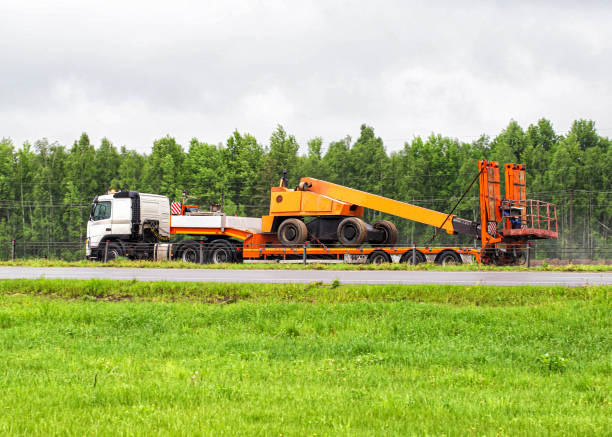What Are Common Risks in Equipment Transportation?

Table of Contents
ToggleTransporting heavy equipment, such as construction machinery, industrial tools, or oversized vehicles, is a highly complex process that demands meticulous planning and execution. These loads, often exceeding standard size and weight limits, present unique challenges that require specialized handling. Risks such as equipment damage, delivery delays, or safety hazards can disrupt operations and impact project timelines. Ensuring safe and efficient transportation relies on strategic approaches, including the use of platforms like Truckpager to streamline logistics.
Risks in Transportation
Improperly secured equipment can shift during transit. This risks damage or accidents. Proper securing techniques are vital. Truckers must use suitable tie-downs. This ensures load stability.
Regulatory Compliance
Transportation of oversized equipment needs permits. Regulations vary by state. Non-compliance causes fines or delays. Understanding permits is crucial. This ensures legal operations.
Environmental and Route Risks
Adverse weather, like rain, affects transportation safety. Slippery roads reduce traction. This may cause delays or accidents. Planning for weather is essential. Truckers must monitor forecasts.
Route Restrictions
Oversized loads face route limits, like low bridges. Poor planning causes delays or risks. Route analysis is necessary. This ensures compliance. It avoids obstacles.

Equipment and Vehicle Risks
Heavy loads strain trucks and trailers. Mechanical issues, like tire failures, pose risks. Regular maintenance prevents breakdowns. This ensures safe transportation. Ask about maintenance schedules.
Incompatible Trailers
Wrong trailers can damage equipment. Lowboys suit tall loads; flatbeds handle versatile cargo. Mismatched trailers risk instability. Trailer compatibility is critical. This ensures safe transport.
Safety Protocols for Risk Mitigation
Robust safety protocols minimize transportation risks. These include training and monitoring. Ask about safety measures. Strong protocols prevent accidents. They ensure reliable operations.
Human and Operational Risks
Long hauls cause fatigue, leading to errors. Mistakes in securing or navigation risk safety. Strict rest schedules are necessary. This ensures alert drivers. Ask about fatigue policies.
Communication Issues
Poor communication causes delays. Misunderstandings about load details create risks. Clear updates are essential. Truckpager enhances coordination. This improves efficiency.

Conclusion
Equipment transportation faces risks like load securing, compliance, and weather issues. Proper planning and maintenance mitigate these challenges. Experienced truckers with suitable equipment are key. Truckpager streamlines logistics and boosts safety. Addressing risks ensures secure delivery.
FAQs
What are key risks in equipment transportation?
Load securing, compliance, and weather are main risks. These cause damage or delays. Experienced truckers use planning to mitigate them. Truckpager improves safety.
How can load securing be ensured?
Ask about securing techniques. Use proper tie-downs for stability. Experienced operators follow tested methods. This prevents damage and ensures safety.
Why are permits important for oversized loads?
Permits ensure compliance with regulations. They vary by state. Proper permits avoid fines and delays. They ensure legal transportation.
- Arts & Style (100)
- Automobile (287)
- Business (5,607)
- Business and Entrepreneurship (165)
- Career Development (55)
- Climate & Environment (26)
- Creative (34)
- Culture (1,549)
- Beauty (279)
- Skincare (240)
- Cultural Studies (75)
- Digital Life (73)
- Energy Healing (31)
- Fashion (1,032)
- Clothing (693)
- Fashion Design (233)
- Philosophy (7)
- Morality (6)
- Religion (17)
- Sports (116)
- Beauty (279)
- Digital Marketing (338)
- DIY and Crafts (15)
- Economics (8)
- Education (1,274)
- Entertainment (198)
- Faith & Spiritual (10)
- Fashion and Beauty (155)
- Finance and Money Management (209)
- Fitness and Exercise (32)
- Food and Drink (169)
- Game (140)
- Health and Wellness (1,094)
- Home and Garden (385)
- Law (141)
- Lifestyle (1,363)
- Health (678)
- Home (383)
- Architecture (94)
- Interior Design (216)
- Rental Property (27)
- Pets (75)
- Relationships (70)
- Restaurants (19)
- Literature (7)
- Media (271)
- Packaging (41)
- Politics (1)
- Real Estate (257)
- Science and Nature (14)
- SEO (137)
- Social Media Marketing (51)
- Software Development (221)
- Sports and Fitness (44)
- Technology (841)
- Artificial Intelligence (239)
- Blockchain (61)
- Data Science (114)
- Gadgets (144)
- Security (139)
- Transportation (108)
- Travel & Tourism (743)
- Uncategorized (1,932)
- World (62)
- International (59)
- 5 Vegan Skincare Secrets for Sensitive Skin

- Reliable Handyman Services in Murrieta: Your Home Repair Partner

- High Class Call Girl Service Jaipur Luxury Escorts for Memorable

- High Class Call Girl Service Kota | Exclusive Escorts for Occasion

- Building Future-Ready Businesses with a Mobile App Development Company New York


Reliable Handyman Services in Murrieta: Your Home Repair Partner

High Class Call Girl Service Jaipur Luxury Escorts for Memorable

High Class Call Girl Service Kota | Exclusive Escorts for Occasion

Book Boxes: The Best Way to Protect and Store Books

Solving Dispenser Problems: Reliable Repair Services in Tallahassee

Clogged Vent Hood Filters? Professional Cleaning and Repair Services

What Are Common Risks in Equipment Transportation?
